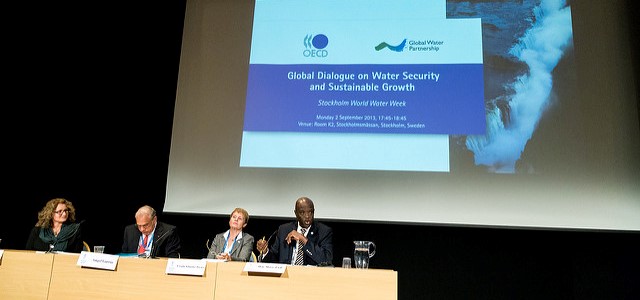One of the first attempts to quantify this investment estimated that annual funding related to water in all its aspects would need to double – to around $180 billion – over the following two decades (GWP, 2000). Other estimates have appeared since then, including adjustments to allow for the impact of climate change (World Bank, 2010). Past neglect, under-investment and under-funding of water cannot continue without disastrous effects.
In this section, the term “investment” is used in its economic sense of the creation of a productive asset which yields benefits over a future period. Investment is needed in the conservation, management and development of the natural resources which underpin water supply (watersheds, catchments, river courses, wetlands, aquifers). Likewise, it is also needed in the creation of hard (pipelines, dams, treatment works, pumps, distribution systems, hydropower stations), and soft infrastructure (administrative overheads, research & monitoring, consumer services, IT systems).
The cost of this investment needs to be financed in various ways – charging water users, investments from government budgets, external aid, commercial loans and equity. Most of the water infrastructure investment traditionally comes from the public domain. However, in recent times, there is a growing involvement of water users’ associations and private commercial entities in sharing these costs. Capital investment entails not only the one-off initial outlay, but also the sizeable recurring expenses of operation, maintenance, repairs and replacements. These operation costs may, in some cases, very well exceed the annual investment costs.
Although investment and financing are separate decisions, subject to different criteria, there is a close synergy between the two. Unrealistically high investment plans, which cannot be fully funded, can lead to:
- “White elephant” projects (assets that are so expensive to maintain that they ultimately ruin the owner);
- Uncompleted schemes;
- Infrastructure that does not deliver proper services;
- Investment budgets used up on high visibility projects serving a minority;
- Premature obsolescence due to inadequate maintenance;
- Funding corruption activities where the governance system is weak.
These mismatches can be avoided, or reduced, by using a decision framework such as Strategic Financial Planning (described in section A3.02) that aims to harmonise investment and financing decisions. There is also scope for financial engineering aiming for matching the structure of a project with the different types of finance available.
Discussions of investment and financial requirements for water tend to be biased towards the physical infrastructure involved in the provision of services, which are visible, socially and politically sensitive. Also, these have a greater potential for generating revenues, compared with water resource conservation, environmental protection, and other aspects of water stewardship. Many of the latter are public goods dependent on public initiatives and public budgets for most or all of their funding. Some types of public goods have major financial costs (strategic storage dams and reservoirs, flood control structures, multi-purpose storage schemes, wastewater treatment plants, bulk water conveyances).
Water is widely considered to a problematic area for attracting funding – much more so than for transport, telecommunications, energy or power. This is due to a number of factors: the poor creditworthiness of borrowing institutions, the low levels of tariffs and cost recovery, political interference with operations, lack of suitable collateral, and the capital-intensive, long term nature of major infrastructures. Also the water sector tends to be regulated in a way that might generate so-called regulatory risks for investors – i.e. the risk of being at the mercy of arbitrary decisions made by official and regulators. In addition, water is prone to foreign exchange risk since its revenues arise principally in local currency, whereas its liabilities to foreign lenders and equity investors need servicing in foreign exchange. Finally, the greatest returns related to water investment are normally long term and non-monetary ones (e.g. improvements in health), thus making them not so attractive from a private investor’s point of view.
Adopting an integrated water resource management strategy does not significantly amplify the traditional needs for water investments, if anything, it actually boosts investment efficiency made in this sector. Within the general framework of Strategic Financial Planning (A3.02) a consensus is forming around the “3Ts” approach. This starts by recognising that water is ultimately paid for from one of three sources - Tariffs, Taxes, and/or Transfers (from external or other philanthropic sources). The 3Ts create a stream of future revenues that can be used to leverage commercial sources of funding – loans and equity – which eventually have to be serviced and repaid from these revenues. The IWRM vision for investments structures is to focus on the elements of sustainable financing for water while enhancing the overall financial coordination in ways that will ultimately minimize misallocation and investment failures.

